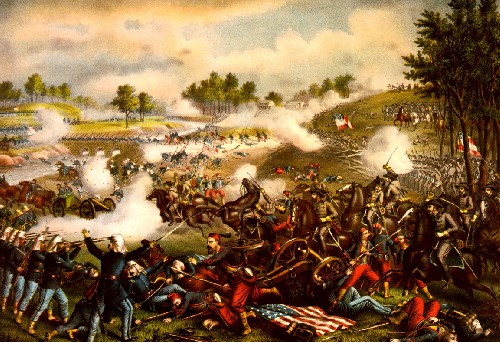
Benjamin Harrison’s presidency began with a dramatic, three-day centennial commemoration of George Washington’s
inauguration as the first president of the United States. The festivities began on April 28, 1889 with a reception in the White House, followed by a reenactment of George Washington’s crossing of New York Harbor by barge under a fuselage of gun salutes and fireworks. The evening was capped with a lavish banquet, featuring thirteen wines and thirteen toasts in honor of the original thirteen colonies.
Despite the initial fanfare, Harrison and his family dined rather modestly during their four years in the White House, and it has been said that their Christmas dinner was about as unpretentious as the family itself. According to culinary historian Poppy Cannon:
The dinner began with Blue Point oysters on the half shell, followed by consomme a la Royale, chicken in patty shells, and then the piece de resistance, stuffed roast turkey, cranberry jelly, Duchess potatoes and braised celery. Then came terrapin a la Maryland, lettuce salad with French drssing, and assorted desserts: minced pie, American plum pudding, tutti fruitti ice cream. For those still hungry, ladyfingers, Carlsbad wafers, and macaroons were passed, followed by fruit and coffee...
But of all White House holiday traditions, the Harrison's are perhaps most well-known for setting up the first decorated Christmas tree in the White House. According to
White House historians, it was on the morning of December 25, 1889 that President Harrison "gathered his family around the first indoor White House Christmas tree. It stood in the upstairs oval room, branches adorned with lit candles. First Lady Caroline Harrison, an artist, helped decorate the tree."
As our nation's First Lady,
Mrs. Harrison set the stage for what would eventually become a White House holiday tradition. But not all First Families after the Harrisons set up Christmas trees in the White House. First Lady Grace Coolidge did in the 1920s; however, it was First Lady "Lou" Henry Hoover who started the custom in 1929 when she oversaw the decoration of the first "official" tree. Since then, the honor of trimming the main White House Christmas tree has belonged to the
First Ladies. According to the White House Historical Association:
In 1961, First Lady Jacqueline Kennedy began the tradition of selecting a theme for the official White House Christmas tree. She decorated a tree placed in the oval Blue Room with ornamental toys, birds and angels modeled after Petr Tchaikovsky's "Nutcracker Suite" ballet. Mrs. Kennedy reused these ornaments in 1962 for her children's theme tree. Set up in the North Entrance, this festive tree also featured brightly wrapped packages, candy canes, gingerbread cookies and straw ornaments made by disabled or senior citizen craftspeople throughout the United States.
The Lyndon B. Johnson Administration began during a time of great uncertainty. In November 1963, the assassination of President Kennedy had stunned America. New First Lady Claudia "Lady Bird" Johnson certainly felt a desire to help the nation heal. She chose comforting and nostalgic holiday decor during her White House years. Her 1965 and 1966 Blue Room Christmas trees were decorated in an early American theme. They featured thousands of small traditional ornaments, including nuts, fruit, popcorn, dried seedpods, gingerbread cookies and wood roses from Hawaii...
Handmade crafts set the theme for First Lady Betty Ford's 1974 Blue Room tree. Emphasizing thrift and recycling, Mrs. Ford used ornaments made by Appalachian women and senior citizen groups. Swags lined with patchwork encircled the tree. She kept this quaint feel in 1975 for her "old-fashioned children's Christmas" theme. Experts from Colonial Williamsburg adapted paper snowflakes, acorns, dried fruits, pinecones, vegetables, straw, cookies and yarn into ornaments...
Last year, the White House theme for the holiday season was "Shine, Give, Share," which offered "an opportunity to pay tribute to our troops, veterans, and their families throughout the White House." The official tour featured 37 Christmas trees (30 are natural trees and 7 are made from paper, felt or aluminum) and a gingerbread model of the White House made of 400 pounds of gingerbread, white chocolate, and marzipan. But the centerpiece was the official Christmas tree which honored our men and women in uniform and featured holiday cards created by military children.
According to
whitehouse.gov, the cards were collected from United States military installations around the world...Medals, badges, and patches from all of the military branches are displayed on ornaments, historic military images are displayed with volunteer-made pinecone frames, and ribbons inspired by the Armed Forces colors represent the brave women and men who protect our Nation and defend our freedom."
FOOD FACT: The White House holiday décor also included "a bounty of Bos!" With a playful nod to the
First Dog, the tour route featured five "Bo topiaries made from various materials like felt (35 yards of wool felt used), buttons (318 buttons in total), pom poms (750 pom poms used), and candy (12 marshmallows and 1,911 pieces of licorice!).
 At the end of the Civil War, the South lay in ruins. Southern plantations and entire cities had been destroyed during the war. Without food, many southerners starved to death, and some of those who survived lost everything they owned.
At the end of the Civil War, the South lay in ruins. Southern plantations and entire cities had been destroyed during the war. Without food, many southerners starved to death, and some of those who survived lost everything they owned. 

